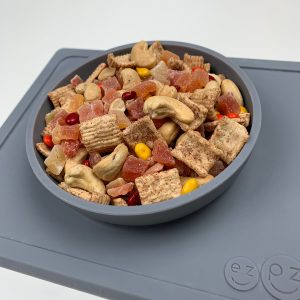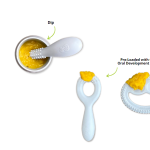Fruit & Veggie Smoothies for Babies

Smoothies are an excellent way for babies to explore a variety of textures, tastes, and temperatures. It’s also a common feeding therapy technique I use to help babies develop their open cup milestones. Here are a few tips to help you introduce smoothies to your little one.
Age of Introduction
A smoothie is a thick puree. So you can offer this texture to a 6-month-old baby if they show all the signs of readiness to eat. Remember, it’s essential to start introducing smoothies to your baby from an open cup (instead of a sippy cup) since drinking from an open cup (held by an adult) is a six-month-old developmental milestone.
- Open Cup: I designed the ezpz Tiny Cup to help babies achieve their open cup feeding and swallowing milestones, thereby reducing their choking risk. The Tiny Cup is a food-grade, safe, silicone cup that holds 2 ounces of breastmilk, formula, or smoothie! It comes in various colors and is a safe way to explore the introduction of different temperatures (warm breastmilk + cold smoothie) to your baby!
Texture Introduction
Offering a variety of textures at mealtime (including different smoothie consistencies) will help decrease picky eating. Here are a few textures to try:
- Thick Consistency: In general, smoothies have a slightly thick consistency that is easy for a baby to sip and swallow easily from an open cup.
- Thicker Consistency: You can also make smoothies with an even thicker texture by combining a little less liquid and more solids. Changing up the consistency is key to having an adventurous eater (and drinker).
- Lumpy Consistency: Depending on the ingredients (chia seeds, ricotta cheese, etc.) and how long you blend your smoothie, you can offer a yummy, lumpy texture.
Ingredient Introduction to Young Babies (6-9 mos)
Have you been wanting to make a smoothie for your baby but are nervous about which ingredients to add? When you first offer a smoothie to your baby’s food rotation, you will want to keep the ingredient list short. Use my “BASE + BLEND” method. Start with breastmilk or formula (the BASE), then add two additional ingredients (the BLEND). Here are a few smoothie examples using this method with fruits and veggies.
- Smoothie BASE: breastmilk / formula
- Fruit BLEND Ideas: banana, avocado, pineapple
- Veggie BLEND Ideas: spinach, cooked carrot, cooked sweet potato
Ingredient Introduction to Older Babies (9+ mos)
After a few months of 3-ingredient smoothies, you can use my BASE + BLEND method to start experimenting with two additional ingredients (five ingredients total). Here are few examples of fruit and veggie blends to try:
- Smoothie BASE: breastmilk / formula
- Fruit BLEND Ideas: nectaries, blueberries, fig
- Veggie BLEND Ideas: kale, bok choy, pumpkin
Troubleshooting Smoothie Refusal
Are you wondering what to do if your baby refuses to drink a smoothie from an open cup? Sometimes a baby only wants breastmilk or formula in their cup and will refuse to drink anything else. When this occurs, you can preload the smoothie onto a spoon just like you would any other puree. Expert tip: When using the spoon technique, scoop the “smoothie bite” from the open cup (not a bowl).
- Patience: Oftentimes, this spoon technique will take a few repetitions before baby becomes disinterested in the spoon and more comfortable drinking the smoothie directly from the open cup. Be patient; it will happen!
- Temperature: Some babies love an icy smoothie, while others want it slightly chilled or at room temperature. Play with the temperature of the smoothie to help encourage your little one to drink it!
Drinking a smoothie from an open cup is a practical (and developmental) way for your baby to expand their tastes and reach their developmental milestones. And if you try using the Tiny Cup or any other baby-led weaning products I designed, be sure to tag me in your pics with the hashtag #MsDawnSLP.





